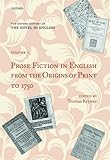Prose Fiction in English from the Origins of Print to 1750 :Volume-1 edited by Thomas Keymer. The Oxford History of The Novel in english/
Material type: TextLanguage: English Series: Oxford history of the novel in English ; volume one.Publication details: New York, NY : Oxford University Press, 2017.Edition: First editionDescription: xxxi, 637 pages : illustrations ; 26 cmISBN:
TextLanguage: English Series: Oxford history of the novel in English ; volume one.Publication details: New York, NY : Oxford University Press, 2017.Edition: First editionDescription: xxxi, 637 pages : illustrations ; 26 cmISBN: - 9780199580033
- 0199580030
- 823.009 23 KEY
| Item type | Current library | Collection | Call number | Status | Date due | Barcode |
|---|---|---|---|---|---|---|
 Reference Books
Reference Books
|
CUTN Central Library Literature | Reference | 823.009 KEY (Browse shelf(Opens below)) | Not For Loan | 41654 |
1. Fiction in the Marketplace 2. Early modern fiction - sources and modes 3. Restoration fiction and the rise of the novel
Explores the long period between the origins of printing in late fifteenth-century England and the establishment of the novel as a recognized, reputable genre in the mid eighteenth century. Later chapters in the volume provide original, authoritative accounts of innovations by the major canonical authors, notably Defoe, Richardson, and Fielding, who have traditionally been seen as pioneering "the rise of the novel," in Ian Watt's famous phrase. With its extended chronological and geographical range, however, the volume also contextualizes these eighteenth-century developments in revelatory new ways, to provide a fresh, bold, and comprehensive account of the richness and variety of fictional traditions as they developed over two and half centuries. This volume thus establishes newly comprehensive mapping of early fiction that rectifies the shortcomings and exclusions of established "rise of the novel" scholarship. These include the relative neglect of the importance of women writers, following Behn's reinvention of romance in the 1680s, in shaping novelistic themes and techniques; a restrictive generic definition based on circumstantial and psychological realism to the exclusion of non-realist modes that flourished for centuries beforehand; a teleological bias that overlooks or downgrades phases and types of fiction production, such as the richly variegated category of Elizabethan fiction, that resist being assimilated into narratives of evolution or ascent; a reductive Anglocentrism that leaves out of account the translation, reception, and pervasive influence form the sixteenth century onwards of, among much else, the "ancient novel" of Apuleius and Heliodorus; Byzantine, Arabian, and Eastern traditions; the Italian novella from Boccaccio to Bandello; Spanish picaresque and anti-romance; and a range of French narrative modes from Rabelais to Marivaux. Alongside these key contexts, the volume treats the emergent novel as, above all, a phenomenon of print culture, with close attention to conditions of authorship, publishing, and reading across the extended period.
Includes bibliographical references (page 595-621) and index.


There are no comments on this title.